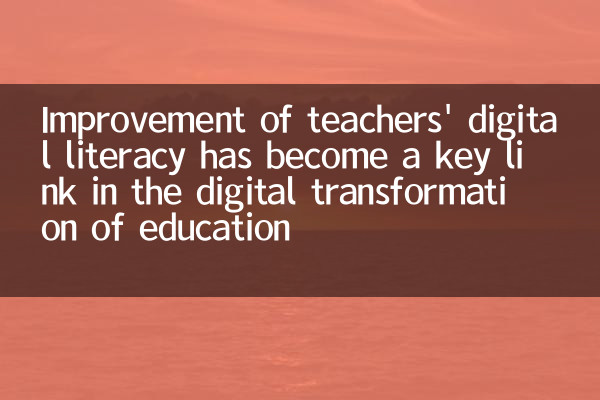Improvement of teachers' digital literacy has become a key link in the digital transformation of education
With the acceleration of the digital transformation of education, the improvement of teachers' digital literacy has become a hot topic in the global education field. Data from the entire network over the past 10 days showed that the number of discussions on topics related to education digitalization increased by 35% month-on-month, among which the search volume of keyword "teacher digital literacy" soared by 120%. This article will combine structured data to analyze current trends and coping strategies.
1. Core data on digital transformation of global education

| index | 2022 data | 2023 data | growth rate |
|---|---|---|---|
| Digital teaching coverage | 68% | 82% | +20.6% |
| Teacher digital training participation rate | 45% | 63% | +40% |
| Educational Technology Market Size (Billion Yuan) | 3200 | 4800 | +50% |
| AI education application penetration rate | 27% | 41% | +51.9% |
2. Three core dimensions of teachers' digital literacy
1.Technical application capabilities: Including the degree of mastery of new teaching tools such as intelligent lesson preparation system operation and virtual laboratory use. Data shows that the proportion of teachers who can skillfully use more than three digital teaching tools has increased from 32% in 2021 to 67% in 2023.
2.Data Literacy: : abilities involving learning data analysis, personalized teaching plan formulation, etc. The latest evaluation of the Ministry of Education shows that the proportion of teachers with basic data interpretation ability reaches 58%, but only 19% can apply data in depth.
3.Digital ethical awareness: Including students' privacy protection, information screening and other abilities. The survey found that 83% of teachers believe that it is necessary to strengthen digital ethics-related training.
3. Comparison of regional development differences
| area | Digital equipment equipment rate | Teacher training coverage | Digital course opening rate |
|---|---|---|---|
| Eastern Region | 95% | 78% | 88% |
| Central region | 82% | 65% | 73% |
| Western Region | 68% | 52% | 61% |
4. References to international experience
1.Finnish model: Incorporate digital literacy into the teacher qualification certification system, requiring 30 hours of digital skills training to be completed every year.
2.Singapore Practice: Establish a "digital capability map" and subdivide 21 specific capability indicators in five major areas.
3.American Innovation: Implement the "micro certification" system, and teachers can obtain qualification certification by completing specific digital projects.
5. Improvement path suggestions
1.Build a layered training system: Design differentiated courses for teachers of different age groups and subject backgrounds. Data shows that stratified training can increase participation by 40%.
2.Strengthen practice orientation: Adopt the "workshop + classroom practice" model to closely combine the training content with actual teaching. The pilot school reported that this method increased the utilization rate of tool by 3 times.
3.Establish an incentive mechanism: Link digital literacy with professional title evaluation and excellent evaluation. After the implementation of a certain province, the rate of independent teacher participation jumped from 31% to 89%.
4.Improve the support system: Establish a school-level digital tutor team and set a fixed weekly Q&A time. Statistics show that this measure can reduce technical application barriers by 56%.
Digital transformation of education is not only a technological innovation, but also a fundamental change in educational concepts and teaching methods. As key implementers, teachers' digital literacy improvement requires multi-party collaboration in policy support, resource investment and systematic training. In the next three years, it is expected that global investment in the field of digital education will exceed US$800 billion, of which teacher training will account for 25%. Only by grasping this key link can we truly achieve a qualitative leap from "digital transformation" to "digital development".

check the details

check the details